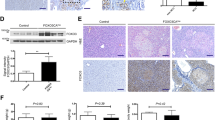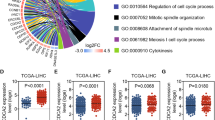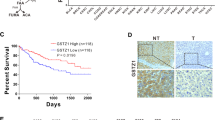Abstract
Reactive oxygen species (ROS) is excessively generated in tumors creating an oxidative stress in tumor microenvironment. We investigated hepatic expression of nuclear factor erythroid 2-related factor 2 (Nrf2) and 8-hydroxydeoxyguanosine (8-OHdG) in hepatocellular carcinoma (HCC) patients, and asked if ROS epigenetically upregulated Nrf2 and enhanced aggressiveness in HCC cells. Expression of Nrf2 (n = 100) and 8-OHdG (n = 53) was remarkably increased in HCC tissues compared with the noncancerous hepatic tissues. Elevated expression of 8-OHdG was associated with poor survival in HCC patients. H2O2, as ROS representative, provoked oxidative stress in HepG2 cells, indicated by increased protein carbonyl content and decreased total antioxidant capacity. Nrf2 expression and 8-OHdG formation were markedly increased in the H2O2-treated cells compared with the untreated control. Co-treatment with antioxidants, tocopheryl acetate (TA) and S-adenosylmethionine (SAM) effectively attenuated expression of Nrf2 and 8-OHdG in H2O2-treated cells. HepG2 cells treated with H2O2 had significantly higher migration and invasion capabilities than the untreated control cells, and this aggressiveness was significantly inhibited by TA and SAM. Bisulfite sequencing revealed that CpG dinucleotides in Nrf2 promoter were unmethylated in the H2O2-treated cells similar to the untreated control. In conclusion, robust histological evidence of increased antioxidative response and oxidative DNA damage in human HCC tissues was demonstrated. Elevated oxidative DNA lesion 8-OHdG was associated with shorter survival. Experimentally, ROS enhanced Nrf2 expression, 8-OHdG formation and tumor progression in HCC cells. These effects were inhibited by antioxidants. Therefore, oxidative stress-reducing regimens might be beneficial to diminish the ROS-induced HCC progression.








Similar content being viewed by others
References
Giannoni E, Parri M, Chiarugi P. EMT and oxidative stress: a bidirectional interplay affecting tumor malignancy. Antioxid Redox Signal. 2012;16(11):1248–63.
Reuter S, Gupta SC, Chaturvedi MM, Aggarwal BB. Oxidative stress, inflammation, and cancer: How are they linked? Free Radic Biol Med. 2010;49(11):1603–16.
Menegon S, Columbano A, Giordano S. The dual roles of NRF2 in cancer. Trends Mol Med. 2016;22(7):578–93.
Dalle-Donne I, Rossi R, Colombo R, Giustarini D, Milzani A. Biomarkers of oxidative damage in human disease. Clin Chem. 2006;52(4):601–23.
Zhang MX, Zhang C, Zhang LM, Yang Q, Zhou SN, Wen QS, et al. Nrf2 is a potential prognostic marker and promotes proliferation and invasion in human hepatocellular carcinoma. BMC Cancer. 2015;15:531–42. doi:10.1186/s12885-015-1541-1.
Cheng ML, Lu YF, Chen H, Shen ZY, Liu J. Liver expression of Nrf2-related genes in different liver diseases. Hepat Pancreat Dis Int. 2015;14(5):485–91.
Chen J, Yu Y, Ji T, Ma R, Chen M, Li G, et al. Clinical implication of Keap1 and phosphorylated Nrf2 expression in hepatocellular carcinoma. Cancer Med. 2016;5(10):2678–87. doi:10.1002/cam4.788.
Kang KA, Piao MJ, Kim KC, Kang HK, Chang WY, Park IC, et al. Epigenetic modification of Nrf2 in 5-fluorouracil-resistant colon cancer cells: involvement of TET-dependent DNA demethylation. Cell Death Dis. 2014;5:e1183.
Wongpaiboonwattana W, Tosukhowong P, Dissayabutra T, Mutirangura A, Boonla C. Oxidative stress induces hypomethylation of LINE-1 and hypermethylation of the RUNX3 promoter in a bladder cancer cell line. Asian Pac J Cancer Prev. 2013;14(6):3773–8.
Poungpairoj P, Whongsiri P, Suwannasin S, Khlaiphuengsin A, Tangkijvanich P, Boonla C. Increased oxidative stress and RUNX3 hypermethylation in patients with hepatitis B virus-associated hepatocellular carcinoma (HCC) and induction of RUNX3 hypermethylation by reactive oxygen species in HCC cells. Asian Pac J Cancer Prev. 2015;16(13):5343–8.
Kloypan C, Srisa-art M, Mutirangura A, Boonla C. LINE-1 hypomethylation induced by reactive oxygen species is mediated via depletion of S-adenosylmethionine. Cell Biochem Funct. 2015;33(6):375–85.
Evans PJ, Whiteman M, Tredger JM, Halliwell B. Antioxidant properties of S-adenosyl-L-methionine: a proposed addition to organ storage fluids. Free Radic Biol Med. 1997;23(7):1002–8.
Patchsung M, Boonla C, Amnattrakul P, Dissayabutra T, Mutirangura A, Tosukhowong P. Long interspersed nuclear element-1 hypomethylation and oxidative stress: correlation and bladder cancer diagnostic potential. PLoS ONE. 2012;7(5):e37009.
Floegel A, Kim DO, Chung SJ, Koo SI, Chun OK. Comparison of ABTS/DPPH assays to measure antioxidant capacity in popular antioxidant-rich US foods. J Food Compos Anal. 2011;24(7):1043–8.
Khor TO, Fuentes F, Shu L, Paredes-Gonzalez X, Yang AY, Liu Y, et al. Epigenetic DNA methylation of antioxidative stress regulator NRF2 in human prostate cancer. Cancer Prev Res (Phila). 2014;7(12):1186–97.
Gopal K, Gupta N, Zhang H, Alshareef A, Alqahtani H, Bigras G, et al. Oxidative stress induces the acquisition of cancer stem-like phenotype in breast cancer detectable by using a Sox2 regulatory region-2 (SRR2) reporter. Oncotarget. 2016;7(3):3111–27.
Ganan-Gomez I, Wei Y, Yang H, Boyano-Adanez MC, Garcia-Manero G. Oncogenic functions of the transcription factor Nrf2. Free Radic Biol Med. 2013;65:750–64.
Ichiba M, Maeta Y, Mukoyama T, Saeki T, Yasui S, Kanbe T, et al. Expression of 8-hydroxy-2′-deoxyguanosine in chronic liver disease and hepatocellular carcinoma. Liver Int. 2003;23(5):338–45.
Jo M, Nishikawa T, Nakajima T, Okada Y, Yamaguchi K, Mitsuyoshi H, et al. Oxidative stress is closely associated with tumor angiogenesis of hepatocellular carcinoma. J Gastroenterol. 2011;46(6):809–21.
Nishikawa T, Nakajima T, Katagishi T, Okada Y, Jo M, Kagawa K, et al. Oxidative stress may enhance the malignant potential of human hepatocellular carcinoma by telomerase activation. Liver Int. 2009;29(6):846–56.
Chuma M, Hige S, Nakanishi M, Ogawa K, Natsuizaka M, Yamamoto Y, et al. 8-Hydroxy-2′-deoxy-guanosine is a risk factor for development of hepatocellular carcinoma in patients with chronic hepatitis C virus infection. J Gastroenterol Hepatol. 2008;23(9):1431–6.
Tanaka H, Fujita N, Sugimoto R, Urawa N, Horiike S, Kobayashi Y, et al. Hepatic oxidative DNA damage is associated with increased risk for hepatocellular carcinoma in chronic hepatitis C. Br J Cancer. 2008;98(3):580–6.
Li S, Wang X, Wu Y, Zhang H, Zhang L, Wang C, et al. 8-Hydroxy-2′-deoxyguanosine expression predicts hepatocellular carcinoma outcome. Oncol Lett. 2012;3(2):338–42.
Coussens LM, Werb Z. Inflammation and cancer. Nature. 2002;420(6917):860–7.
Liu D, Zhang Y, Wei Y, Liu G, Liu Y, Gao Q, et al. Activation of AKT pathway by Nrf2/PDGFA feedback loop contributes to HCC progression. Oncotarget. 2016;7(40):65389–402. doi:10.18632/oncotarget.11700
Jayachandran A, Dhungel B, Steel JC. Epithelial-to-mesenchymal plasticity of cancer stem cells: therapeutic targets in hepatocellular carcinoma. J Hematol Oncol. 2016;9(1):74.
Zhang PF, Li KS, Shen YH, Gao PT, Dong ZR, Cai JB, et al. Galectin-1 induces hepatocellular carcinoma EMT and sorafenib resistance by activating FAK/PI3K/AKT signaling. Cell Death Dis. 2016;7:e2201.
Jing Y, Han Z, Zhang S, Liu Y, Wei L. Epithelial-mesenchymal transition in tumor microenvironment. Cell Biosci. 2011;1:29.
Radisky DC, Levy DD, Littlepage LE, Liu H, Nelson CM, Fata JE, et al. Rac1b and reactive oxygen species mediate MMP-3-induced EMT and genomic instability. Nature. 2005;436(7047):123–7.
Rhyu DY, Yang Y, Ha H, Lee GT, Song JS, Uh ST, et al. Role of reactive oxygen species in TGF-beta1-induced mitogen-activated protein kinase activation and epithelial-mesenchymal transition in renal tubular epithelial cells. J Am Soc Nephrol. 2005;16(3):667–75.
Mahalingaiah PK, Ponnusamy L, Singh KP. Chronic oxidative stress leads to malignant transformation along with acquisition of stem cell characteristics, and epithelial to mesenchymal transition in human renal epithelial cells. J Cell Physiol. 2015;230(8):1916–28.
Ma Q. Role of nrf2 in oxidative stress and toxicity. Annu Rev Pharmacol Toxicol. 2013;53:401–26.
Acknowledgement
This study was supported by the Ratchadapiseksompoch Endowment Fund, Chulalongkorn University (CU-58-001-HR to C.B.). C.M. awarded the 90th Anniversary of Chulalongkorn University Scholarship. We thank Miss Suchittra Phoyen and Miss Pimkanya Morekrong for laboratory assistance. Gratitude to Prof. Wilai Anomasiri for kindly help, advice and support.
Funding
This study was also funded (to P.T.) by the National Research University (NRU59-026-HR) and the Thailand Research Fund (RTA5980008).
Author information
Authors and Affiliations
Corresponding author
Ethics declarations
Conflict of interest
All authors declare that they have no conflict of interest.
Ethical approval
All procedures performed in studies involving human participants were in accordance with the ethical standards of the institutional committee and with the 1964 Helsinki declaration and its later amendments or comparable ethical standards.
Informed consent
Informed consent was obtained from all individual participants included in the study.
Electronic supplementary material
Below is the link to the electronic supplementary material.
Rights and permissions
About this article
Cite this article
Ma-on, C., Sanpavat, A., Whongsiri, P. et al. Oxidative stress indicated by elevated expression of Nrf2 and 8-OHdG promotes hepatocellular carcinoma progression. Med Oncol 34, 57 (2017). https://doi.org/10.1007/s12032-017-0914-5
Received:
Accepted:
Published:
DOI: https://doi.org/10.1007/s12032-017-0914-5




